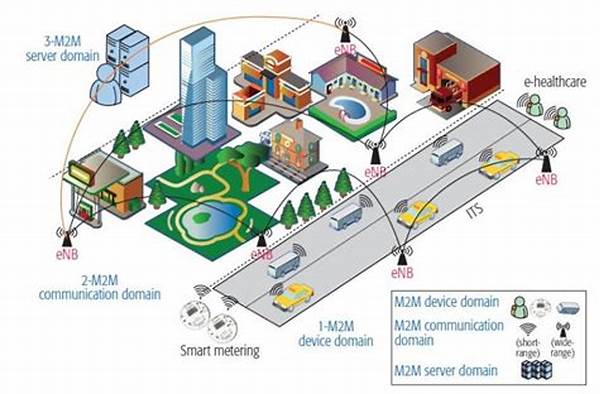In recent years, the advancement of wireless technology has paved the way for significant innovations in telecommunications. A prominent aspect of this evolution is the burgeoning field of massive machine type communications (mMTC). This technological breakthrough is an integral component of the burgeoning Internet of Things (IoT) ecosystem. As the demand for interconnected devices rises, understanding the implications and applications of mMTC is imperative.
The Definition and Scope of Massive Machine Type Communications
At its core, massive machine type communications refers to the network infrastructure that supports extensive connectivity among a multitude of devices. Unlike conventional human-centred communication systems, mMTC is specifically tailored to facilitate machine-to-machine communications. This paradigm enables devices to communicate independently, exchanging data with minimal human intervention. The primary objective of mMTC is to address the challenges posed by the high-density device environment, ensuring efficient data transmission and reliability.
One emblematic feature of mMTC is its capacity to manage a vast number of simultaneous connections. In a typical scenario, these networks can support millions of devices within a single square kilometre. This capability is essential for various applications ranging from smart cities to industrial automation. Moreover, mMTC is characterized by low power consumption and extended coverage, allowing devices to operate efficiently over long periods and distances. This technological advancement promises to revolutionize industries by enabling seamless and autonomous communications between devices, enhancing productivity, and fostering innovation.
Enabling Technologies of Massive Machine Type Communications
1. Cellular IoT Networks: Cellular networks form the backbone of massive machine type communications, providing extensive coverage and reliable connections for myriad devices.
2. Low Power Wide Area Networks (LPWAN): These networks are crucial for mMTC, as they enable long-range communication with minimal energy consumption, supporting sustainable device operation.
3. 5G Technology: The advent of 5G significantly boosts mMTC by offering higher bandwidth, lower latency, and increased connection density, optimally supporting the massive IoT scale.
4. Edge Computing: This technology complements mMTC by processing data closer to the source, minimizing latency, and improving real-time data handling capabilities.
5. Advanced Modulation Techniques: Efficient modulation techniques are employed within mMTC to ensure robust and error-free communication over congested network environments.
Challenges in Implementing Massive Machine Type Communications
The deployment of massive machine type communications systems presents several challenges that necessitate robust solutions. One of the primary concerns is network scalability. As the number of connected devices escalates, ensuring network stability and performance becomes increasingly complex. Network infrastructure must be capable of rapid scaling to accommodate the growing demand without compromising service quality.
Security is another critical aspect of mMTC implementation. With a vast number of connected devices, ensuring the integrity and confidentiality of data transmissions is paramount. Robust encryption methodologies and secure authentication protocols are essential to safeguarding the network against potential cyber threats. Additionally, power consumption remains a significant concern, as IoT devices often operate in resource-constrained environments. Achieving a balance between performance and energy efficiency is vital for the sustainable operation of these networks.
Opportunities Presented by Massive Machine Type Communications
Massive machine type communications open up a plethora of opportunities across various sectors. In the healthcare industry, mMTC facilitates real-time monitoring of patient health through connected medical devices, enabling timely interventions and personalized treatment. Similarly, in agriculture, smart farming practices leverage mMTC for precision farming, optimizing resource usage and crop yields.
Moreover, in smart cities, mMTC enhances urban infrastructure by enabling efficient traffic management, waste management, and energy distribution systems. Industrial sectors, too, benefit from mMTC through enhanced automation and predictive maintenance, minimizing downtime and operational costs. The integration of mMTC into these domains promises to revolutionize traditional methodologies, unlocking unprecedented efficiency and innovation.
Future Prospects of Massive Machine Type Communications
The future of massive machine type communications is poised for remarkable growth and development. As technological advancements continue to unfold, mMTC is expected to play a pivotal role in realizing the vision of a fully connected world. Research and innovation efforts are focused on improving network capabilities, facilitating seamless data exchange, and enhancing device interoperability.
The integration of artificial intelligence and machine learning into mMTC systems holds promise for further optimizing network performance and decision-making processes. By harnessing the power of data analytics, mMTC can achieve enhanced predictive and adaptive capabilities, enhancing its overall efficiency and reliability. Furthermore, ongoing standardization efforts aim to establish uniform protocols and frameworks, ensuring compatibility and interoperability across diverse devices and networks.
Implications of Massive Machine Type Communications on Society
The societal implications of massive machine type communications are profound and far-reaching. By transforming traditional communication paradigms, mMTC reshapes the way individuals, businesses, and governments interact with technology. It fosters innovation in industries, enhances productivity, and enables new business models, contributing to economic growth.
Furthermore, mMTC diverts attention to environmental sustainability by promoting efficient resource utilization through intelligent systems. The pervasive connectivity facilitated by mMTC also raises questions about privacy and data security. As the network landscape evolves, it is essential to address these concerns to foster public trust and ensure ethical and responsible technology adoption. In conclusion, massive machine type communications represent a transformative force with the potential to revolutionize societal interactions and lay the foundation for a more connected future.
Summary of Massive Machine Type Communications
In summary, massive machine type communications is a transformative technology that facilitates extensive connectivity among devices, forming the backbone of the IoT ecosystem. Its ability to support a high density of connections while maintaining low power consumption is critical for various industry applications, including healthcare, agriculture, and smart cities.
Despite the challenges associated with scalability, security, and power efficiency, the promise of mMTC in fostering innovation and enhancing operational efficiency is undeniable. As we continue to explore the potential of mMTC, it is essential to address these challenges, ensuring sustainable and secure connectivity. The integration of emerging technologies such as AI and 5G further amplifies the potential of mMTC, paving the way for a future characterized by unparalleled connectivity and technological advancement.





